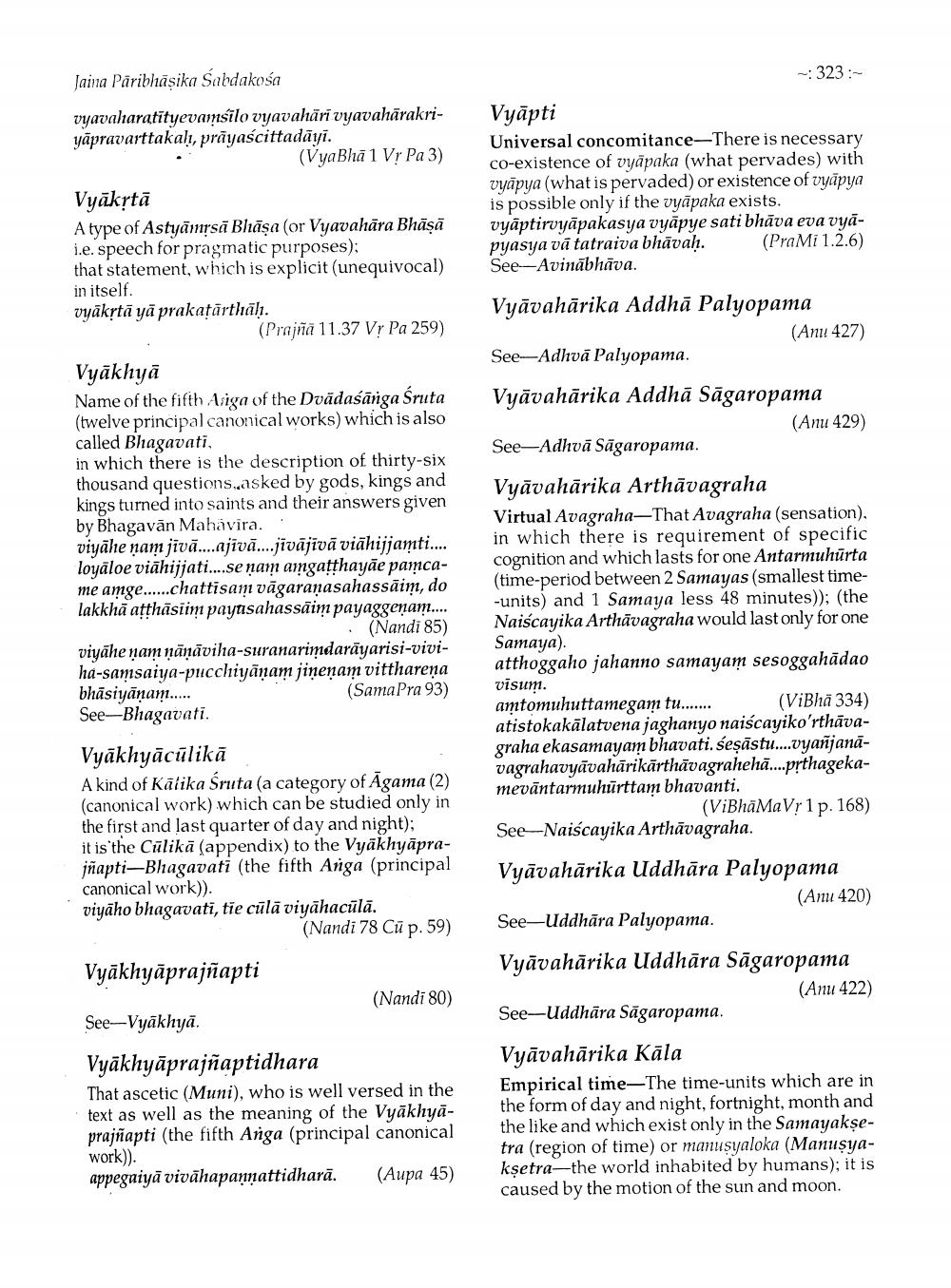________________
Jaina Pāribhāsika Sabdakosa
323
vyavaharatityevansilo vyavahāri vyavahārakriyāpravarttakal, prāyascittadāvi.
(VyaBhā 1 Vr Pa 3)
Vyāpti Universal concomitance-There is necessary co-existence of vyāpaka (what pervades) with vyāpya (what is pervaded) or existence of vyāpya is possible only if the vyāpaka exists. vyāptirvyāpakasya vyāpye sati bhāva eva vyāpyasya vā tatraiva bhāvah. (PraMi 1.2.6) See-Avinābhāva.
Vyākṣtā A type of Astyām;sā Bhāşa (or Vyavahāra Bhäşa i.e. speech for pragmatic purposes); that statement, which is explicit (unequivocal) in itself. vyākstāyā prakatārthāh.
(Prajña 11.37 Vr Pa 259) Vyākhyā Name of the fifth Asiga of the Dvädasānga Sruta (twelve principal canonical works) which is also called Bhagavati, in which there is the description of thirty-six thousand questions asked by gods, kings and kings turned into saints and their answers given by Bhagavān Mahavira.. viyāhe nam jivā....ajīvā....jīvājīvā viāhijjamti.... loyaloe viāhijjati....se nam amngatthayāe pamcame amge....chattisam vāgaranasahassāim, do lakkhā atthāsiim paytisahassāim payaggenam....
· (Nandi 85) viyahe nam ņāņāviha-suranarimdarāyarisi-viviha-samsaiya-pucchiyānam jineņam vittharena bhāsiyānam....
(SamaPra 93) See-Bhagavati.
Vyāvahārika Addhā Palyopama
(Anu 427) See-Adhvă Palyopama. Vyāvahārika Addhā Sāgaropama
(Anu 429) See-Adhvā Sāgaropama.
Vyāvahārika Arthāvagraha Virtual Avagraha-That Avagraha (sensation), in which there is requirement of specific cognition and which lasts for one Antarmuhurta (time-period between 2 Samayas (smallest time-units) and 1 Samaya less 48 minutes)); (the Naiscayika Arthāvagraha would last only for one Samaya). atthoggaho jahanno samayam sesoggahädao visum. amtomuhuttamegam tu...... (ViBhä 334) atistokakālatvena jaghanyo naiscayiko'rthāvagraha ekasamayam bhavati. seşāstu....vyanjanavagrahavyāvahārikārthāvagrahehā....prthagekamevāntarmuhurttam bhavanti.
(ViBhãMaV/1p. 168) See-Naiscayika Arthāvagraha.
Vyākhyācũlikā A kind of Kālika Sruta (a category of Agama (2) (canonical work) which can be studied only in the first and last quarter of day and night); it is the Cülikā (appendix) to the Vyākhyāprajñapti-Bhagavati (the fifth Anga (principal canonical work)). viyāho bhagavati, tie cülā viyāhacūlā.
(Nandi 78 Cū p. 59)
Vyāvahārika Uddhāra Palyopama
(Anu 420) See-uddhāra Palyopama.
Vyākhyāprajñapti
(Nandi 80)
Vyāvahārika Uddhāra Sāgaropama
(Anu 422) See-Uddhāra Sāgaropama.
See-Vyākhyā.
Vyākhyāprajñaptidhara That ascetic (Muni), who is well versed in the text as well as the meaning of the Vyākhyāprajñapti (the fifth Anga (principal canonical work)) appegaiyā vivāhapannattidharā. (Aupa 45)
Vyāvahārika Kāla Empirical time-The time-units which are in the form of day and night, fortnight, month and the like and which exist only in the Samayakşetra (region of time) or manusyaloka (Manuşyakşetra—the world inhabited by humans); it is caused by the motion of the sun and moon.




